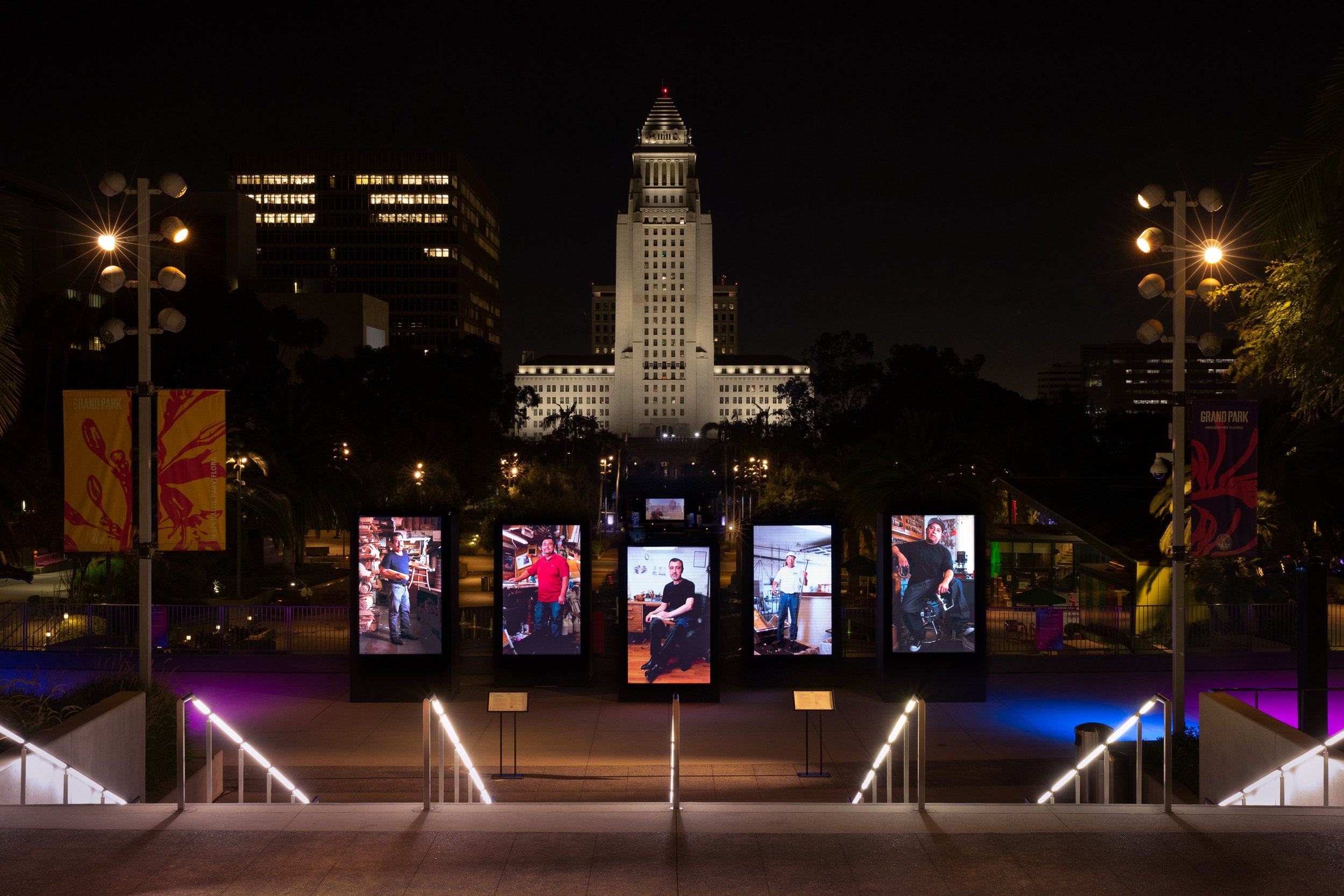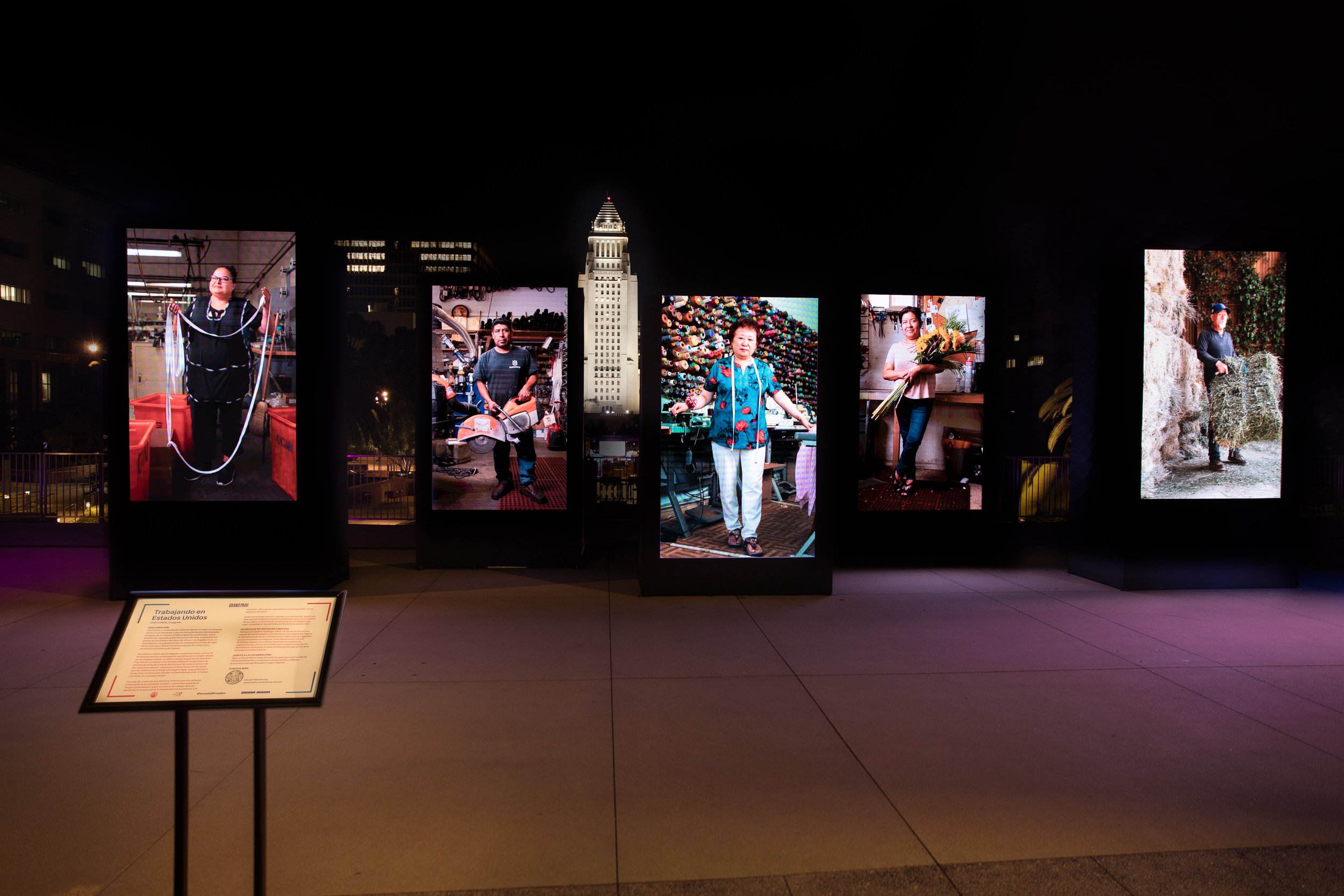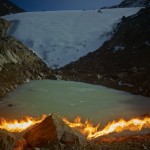Sam Comen: The Longest Shift
Being here at the grocery store, we are front line. We had customers come in here, and they’ll be like, ‘Oh, I have COVID, but I’m fine.’ We’re trying to be safe ourselves, and for somebody to come in and tell you that, it makes me angry. My son has asthma, so it could affect me, because of his breathing problem. So yeah, it gets to me. I’m here, but my brain is running like 1000 miles per hour, just thinking.
It makes me upset, thinking they can’t wear their masks just to come and shop for their groceries for like 20 minutes, 10 minutes, five minutes, but yet I’m standing in the store for nine hours, and having my mask is not optional for me.
When you get all these people that don’t believe in it, that’s where it makes it really hard, because they just start talking and saying that this is not real, probably because it hasn’t affected them. A lot of people have passed away from this. It’s terrifying. Today we’re here. We don’t have tomorrow for granted. Like I always tell the customers, ‘Have a good day. Be safe.’ That’s all I can say. – Jennifer Alcantar
Los Angeles based photographer and video artist, Sam Comen brings a particular humanity to his work, work that elevates the every man/woman (sharing a few install shots of a previous project, Working America, a public art installation that was shown in Grand Park, Los Angeles in 2021.) His new project, The Longest Shift, celebrates essential workers during the pandemic, in particular, Black and Latinx workers, who make us consider the societal inequities in this moment in time. Comen shines a light on those who are often in the shadows, working hard to support others and at the same time support their own. His meaningful work is an important document to the contributions of these important workers who were and are critical components in keeping us safe, fed, and healthy.
Comen is about to open a full scale exhibition at the Lancaster Museum of Art & History, in Lancaster, California on May 14th running through August 21st, with an opening on May 14th from 4-6pm.
Sam Comen has long focused on themes of American identity, community-building, immigration, labor, and social justice in his photography. In shooting environmental portraits of everyday heroes as well as leaders, actors, and artists, he has sought new ways of using light and craft to honor the work of predecessors who shaped the portrait genre, while examining contemporary issues with cutting-edge technology. His work has twice been exhibited at the Smithsonian’s National Portrait Gallery, and is commissioned by brands and magazines internationally.
As a native Californian, Sam has used his home state as a muse throughout his career, and often looks to the places that define us for inspiration. He notably brought this site-specific approach to the series Lost Hills, acquired by the Library of Congress in 2019 and The Los Angeles County Museum of Art in 2021.
His newest body of work, produced in Los Angeles during the height of the COVID-19 pandemic, is The Longest Shift, a series of still photographs, motion portraits, and intimate first-person interviews with the essential workers who remained on the front lines of the pandemic. It will be exhibited at the Lancaster, CA Museum of Art and History (MOAH) as a photographic and video installation from May 14 – August 21, 2022.
Current exhibitions on tour featuring Comen’s work include include The Newest Americans, portraits of U.S. citizens immediately before and after taking the oath, produced in partnership with The California Museum in Sacramento, touring nationally through 2022; and Golden Hour: California Photography from the Los Angeles County Museum of Art, curated by LACMA and touring four Southern CA venues through May of 2022. This fall, Comen’s Working America, which focuses on immigrant Americans and first-generation Americans at work will begin a five-year-long national tour with Exhibits USA.
Tragedy tempered the moments in which these portraits were made. In December 2020 and January 2021, as the country neared the morbid marker of one year under the Covid-19 pandemic, infections and deaths in Los Angeles County had reached a dramatic peak.
It was in this context that I traveled throughout L.A. to document workers – deemed essential – who were thrust to the front lines and asked to keep on the job while the rest of society sheltered at home.
This body of work, focusing largely on Black and Latinx workers, often in jobs that expose striking societal inequities, examines the economic and social forces that shape our communities, their structures laid bare by a deadly pandemic.
Through reverent portrayals of these workers’ in still and motion portraits, this essay celebrates the subjects’ lives, contributions, and resilience. It invites the viewer to reflect on the meaning of work in our society and the value of the labor we all rely on, in hopes of spurring more equitable conditions in a post-pandemic world.
We get the reports, we see colleagues who have passed. You worry more and more each day.
We are risking our health, our lives even, but at the same time, we are helping a lot of people. We are partially responsible for moving the economy, because we move the products that come from other countries and bring them to the supermarkets. You feel like you are making a contribution to the community, to the country.
Seeing that there were shortages of toilet paper, sugar, food, and things like that, and knowing that we are the vehicle that can reach those supermarkets and restock what is missing; that was a great motivation. – Alvaro Altamirano

©Sam Comen, Rebecca Melchor, Sandra Ceja, and Karina Franco, Surgical Technologist and RNs, Harbor-UCLA Medical Center
Rebecca Melchor (left) is a surgical technologist in the Labor and Delivery Operating Room at the Harbor-UCLA Medical Center, where some of the pregnant patients have tested positive for COVID. She said, “I was part of the first crash COVID C-section that we had. It was an emergency C-section, life and death. Sometimes you feel uneasy. I mean, it’s something you feel like you have to do, though. Nobody else is going to do it. We can’t turn a patient away, just because she has COVID. If she’s a pregnant patient, we’re gonna take care of her.”
Sandra Ceja (center), a Labor and Delivery nurse, worries about her family at home, but also empathizes with her patients. She said, “You try to understand what they’re going through. You do your best to take care of them and be kind, and do the best that you can with your fear.”
Karina Franco (right), has been a nurse for five years and has worked in L&D for one year. Despite the pandemic, she said, “It’s been a good experience overall. I’ve learned so much. It makes me feel proud of myself for trying this specialty, which I really enjoy, and being able to help moms having their babies, especially during this pandemic.”

©Sam Comen, Hector Robles, Hyun Joo Kim, Kim Chow, Maria Alviso, Lance Goosby, and Nicole Luckie, USPS Letter Carriers, photographed at Los Angeles’ Foy Station
For letter carriers, the pandemic has meant more mail, more parcels, and more precautions. Hyun Joo Kim (second from left) explained, “I have to wear the mask and wear the gloves, even on a hot day. Physically, it is a little hard, but it’s okay. We have to do it.”
Nicole Luckie (right) said, “I’m finding my way through this. When you’re out on the street, you have some customers that will come up to you, and they don’t have a mask on, and then they get mad at you when you don’t want to talk to them or take their mail from them. I’m like, ‘Okay, wait a minute, my son has chronic asthma, my mother has kidney failure, and my sister has lupus, so I can’t afford to bring anything home.’

©Sam Comen, Uriel Rivera Cortez, Former Amazon Warehouse Worker, Photographed outside a massive Amazon fulfilment center where 6,000 people are employed.
I would like people to put themselves in our shoes and reflect on what it is like to work in a warehouse like this one. I would like all the customers, everyone who buys at Amazon, to care at least a little for the employees. If the people cared a little about essential workers, they would take less advantage of us, and it would be a lot safer for us to go to work and continue to work for the company. – Uriel Rivera Cortez

©Sam Comen, Carlos Arevalo, Jason Calixto, Esbeida Refugio, and Ray Miller, Custodial Staff, Los Angeles County + USC Hospital
The custodians responsible for cleaning and decontaminating L.A. County + USC Hospital understand that their work is of critical importance. Jason Calixto (second from left) said, “The burden falls on us to protect not only staff, but society, our community, and the public. We have to do everything that we can to protect everybody that comes into the hospital, those that visit the hospital, ourselves, and our families as well. I’ve stayed away from my extended family for 5 months.”
For Carlos Arevalo (left), “The hardest part was when we reached the highest level of contagion, and almost all the hospital was full, at all units. I saw the patients face to face. I saw some I thought were about to pass, but thank God they started getting better, and they made a full recovery and were able to go back home.”
To keep her two-year-old son safe, Esbeida Refugio (third from left) leaves him with a babysitter during the week, while she’s working. She said, “That’s the hardest thing. It’s kind of heartbreaking leaving my son, but I’m really scared that he’s gonna get exposed.”

©Sam Comen, Fanny Ortiz and daughter Maia, age 14, In-Home Supportive Services Healthcare worker, from The Longest Shift
I am a care provider for my younger daughter, Maia, who’s 14 years-old and was born with total anomalous pulmonary venous reversal [a birth defect of the heart.] Maia’s legally blind, quadriplegic, and needs care around the clock. I’m privileged to get paid through IHSS as a home care provider for Maia.
I was petrified that once I lost my prior job (due to her COVID infection) I wasn’t going to be able to pay rent. And eventually, I had to decide that to survive, and for my kids to survive, I had to stop paying rent and instead make sure that we all eat and take care of ourselves.
If I was a fierce advocate before, I’m even more fierce now. I’m gonna do what I have to do to make sure that we survive. The working class people, we always hustle, we’re always doing what we have to do for our families. COVID has highlighted the inequities that communities of people of color have suffered historically. – Fanny Ortiz

©Sam Comen, Vince Mena, Dale Smith, Kristina “Kady” Kepner, and Brandon Terrazas, City of Los Angeles Fire Department Firefighters, Photographed at Station 3 in Downtown L.A, from The Longest Shift
Vince Mena (left) had been with the Los Angeles Fire Department for 34 years, but hadn’t ever felt resistance from members of the public he served: I don’t think people were always aware that we are just there to help. We were kind of caught in the middle of the political part of the entire thing. Wearing a badge, we could be looked at negatively sometimes, representing the government, even though we’re firefighters. And sometimes it wasn’t recognized that we’re trying to do our best to help people, that we’re human.”
Captain Dale Smith (second from left) said, “We’ve had a couple of healthy firefighters on the job in L.A. City that have passed from COVID. All the contact that we have within the community definitely raises our exposure levels, which has been pretty tough. We can take all these precautionary measures, but we’re not immune to this. It will affect us just like it will anybody else.“
Because Los Angeles County has a public health department, but the City of Los Angeles does not, the mayor asked the fire department to assist with the development of COVID testing sites. Kady Kepner (second from right), Assistant Chief, oversaw that initiative. She shared, “It has definitely been a challenge for all of us, as it has for everyone. We’ve had to implement new protocols, policies, and a whole bunch of new and innovative ways to continue to be able to do our job and provide exceptional customer service to the communities that we serve.”

©Sam Comen, Russell Griffith, Mario A. Gonzalez, Marie Geelan, Vanessa Johnson, and Janae Torrez, L.A. County Public Defenders, Compton Superior Court, from The Longest Shift
“We’re in here every day. I think there’s a misconception that courts have been shut down or that courts are not in place, or that we’ve been on a break. But we’ve been in here since the beginning. I contracted COVID in June from a client,” said Janae Torrez (right.)
Even when precautions are taken, the likelihood of exposure is high. Russell Griffith (left) explained, “The clients are living in a jail, which is a hotbed for the disease, and a lot of them are mentally ill and don’t necessarily have the best habits to begin with. And it’s very hard for people to keep their mask up, even if they want to, when they’re handcuffed.”
Mario A. Gonzalez (second from left) said, “At the beginning of the pandemic, the DAs agreed to dismiss certain cases, low-level misdemeanors, that are not violent and aren’t sexual in nature. But as the pandemic has progressed, the caseload has increased significantly, which has been stressful on us.”
During a recent case, Vanessa Johnson (second from right) thought a witness was lying during their testimony, but the judge wasn’t listening to her objections. She recalled, “The Spanish interpreter asked me afterwards, ‘Did you notice the witness took his mask off?’ I was like, ‘Are you serious?’ I was so focused on the work part that I wasn’t even looking at the fact that I could see his mouth.”
Marie Geelan (center) pointed out that public defenders have always had a tough job. “This is another layer of toughness, but honestly, we’re up for it. We’re doing it, and I feel very proud to have been keeping safe. This is what we do—we get up, suit up and show up.”
The first hurdle we had to overcome was fighting for PPE. We didn’t have enough protection to take care of the patients. We were asked to wear the same mask, and I knew that wasn’t safe. We didn’t know how to treat patients. There was no rulebook. There were people coming in the hospital that were sick. I started having friends that were sick, and no one really knew what was going on.
There were times when I came home and I cried; there were times when I cried on my way home. There were times where I had to stay over, because my coworkers were sick. The hardest part, though, was not being able to have family in the hospital with the patients. We were patients’ lifelines. It was a change. We were all forced to put ourselves in other people’s shoes, and we’re still doing it.
This has been the most trying time of my career. I want people to know that we do the best we can with what we have. – Terri Thompson

©Sam Comen, Alberto Gomez, Candy & Toy Vendor, Photographed at Wilshire Blvd and Vermont Ave, on his daily route, from The Longest Shift
I’ve been doing this for 28 years. The pandemic impacted our work a lot. We could only go out on the weekends, sales dropped. I had to walk more, looking for different areas with more people.
Sometimes there are ladies who can’t afford to buy things for their children, so I cut them a deal. I know it seems like I’m losing, but I don’t lose: I know I win. God is looking at every one of my actions from above. – Alberto Gomez
Posts on Lenscratch may not be reproduced without the permission of the Lenscratch staff and the photographer.
Recommended
-
Earth Week: Simon Norfolk: When I am Laid in EarthApril 27th, 2024
-
Shinichiro Nagasawa: The Bonin IslandersApril 2nd, 2024
-
The International Women in Photo Association Awards: Lorraine Turci: The Resilience of the CrowMarch 16th, 2024
-
The International Women in Photo Association Awards: Rayito Flores Pelcastre: Chirping of CricketsMarch 14th, 2024
-
The International Women in Photo Association Awards: Louise Amelie: What Does Migration Mean for those who Stay BehindMarch 12th, 2024



































































